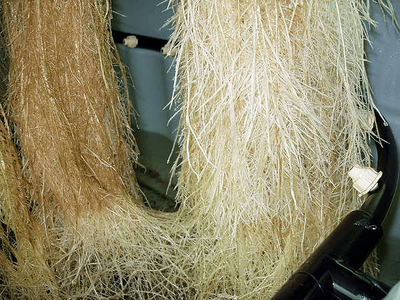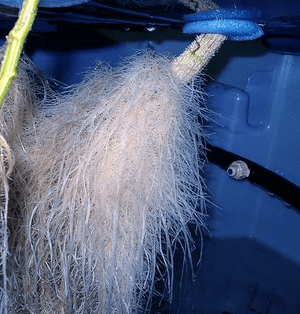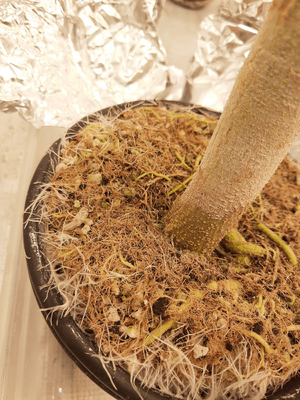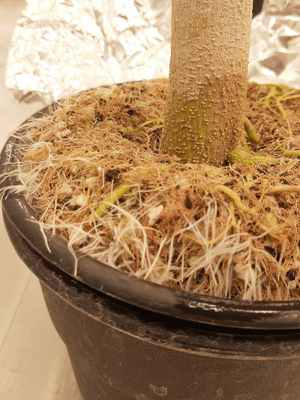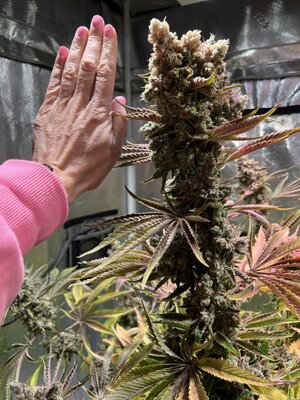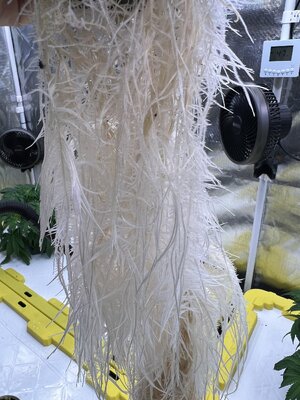How to install the app on iOS
Follow along with the video below to see how to install our site as a web app on your home screen.

Note: This feature currently requires accessing the site using the built-in Safari browser.
You are using an out of date browser. It may not display this or other websites correctly.
You should upgrade or use an alternative browser.
You should upgrade or use an alternative browser.
Is there any truth to the saying 'bigger the roots, bigger the fruits' when growing cannabis?
- Thread starter Mars_Barz
- Start date
Observer
Quantum Yield Engineer
- Joined
- May 11, 2023
- Messages
- 7,847
- Reaction score
- 19,296
Pretty much, a small root system can support a large plant, I'm sure theres a maximum correlation amount of root zone-to-canopy size but yea, a bigger pot also does not mean 100% or so of that media is actually going to rootzone,So the takeaway I'm seeing here is with fertigation a large root system is not necessary due to the frequent feeds?
SO, you balance that pot size with you're vertical space available.
A 5x5 tent with 5-6 foot of ceiling, anything more than a gallon really is a waste/loss of utilization and optimization, and efficiency, using more media than is actually needed for example.
I used HALF of the 1 gallon bags of coco on an unoptimized watering schedule and still did not have to break my back watering, just once or twice a day, coco perlite, even through flower, but again, not optimized, didn't need alot of media, took most the space up in the tent still, had a few feet left to work with for canopy.
Smaller media volume leads to a tight/compact dense root zone, and the growth media plays a role as well.
Last edited:
Observer
Quantum Yield Engineer
- Joined
- May 11, 2023
- Messages
- 7,847
- Reaction score
- 19,296
I dont see why not, the coco will act like a wick alongside the roots.I have been reading alot of good things about the autopots. I looked for 1 gallon autopots but the smallest ones I found were 3 gallon versions. I always thought that bottom feeding coco was a no go.
People do "swamp" grows where they just put there fabric pots in trays and flood the tray. They let the pots/plants absorb and then can drain excess water.
it just boils down to the root zone environment condition/variables.But with my current Grow I am learning to fertigate when needed and I have not had any issues so far. So I am not feeding until runoff every time. Once a day at most. So I bet if you top feed once a week until runoff in autopots you can have great success.
And feeding till run off is not a requirement, or end all be all.
a balance between E.C, pH, O2 and WC% is.
Observer
Quantum Yield Engineer
- Joined
- May 11, 2023
- Messages
- 7,847
- Reaction score
- 19,296
Plus, it takes less time for that root zone to develop a nice densely nurturing root ball in a smaller pot.So the takeaway I'm seeing here is with fertigation a large root system is not necessaryVreeland due to the frequent feeds?
- Joined
- May 11, 2023
- Messages
- 2,518
- Reaction score
- 10,574
Remember there is a difference between root mass, root structure and container size.
You can have the same root mass in a 1 gal pot and a 3 gal pot. Just because the pot is bigger doesn’t mean it has a larger root mass. The roots are just more dense in a smaller container and thus requires more effort in keeping a stable root zone and supply of nutrients. Gas exchange is faster because of less media and growth is increased.
The term rootbound as it is used by us cannabis growers is 99% BS. They are not rootbound, we are simply not looking after the needs well enough to replenish the small amount of media.
You can have the same root mass in a 1 gal pot and a 3 gal pot. Just because the pot is bigger doesn’t mean it has a larger root mass. The roots are just more dense in a smaller container and thus requires more effort in keeping a stable root zone and supply of nutrients. Gas exchange is faster because of less media and growth is increased.
The term rootbound as it is used by us cannabis growers is 99% BS. They are not rootbound, we are simply not looking after the needs well enough to replenish the small amount of media.
Pipecarver
POTM Winner
- Joined
- Apr 15, 2023
- Messages
- 3,486
- Reaction score
- 16,529
The whole idea behind the autopots in my mind is no top feeding needed.I only half feed my pots after I transplant into the AP's the first time then they feed off the bottom. I use Promix & perlite I know nothing about Coco, Promix is too simple to want to changeI have been reading alot of good things about the autopots. I looked for 1 gallon autopots but the smallest ones I found were 3 gallon versions. I always thought that bottom feeding coco was a no go. But with my current Grow I am learning to fertigate when needed and I have not had any issues so far. So I am not feeding until runoff every time. Once a day at most. So I bet if you top feed once a week until runoff in autopots you can have great success.
moe.red
hydro helper
- Joined
- Apr 1, 2023
- Messages
- 4,638
- Reaction score
- 26,067
I went to RDWC hydro because I do believe bigger roots = bigger fruits.I know Moe used them for a while but I don't know why he stopped, seems so simple maybe that's why, too easy for him.
Not just bigger, but more efficient IMO.
As Aqua said, it is not just the pot size tho. It's the whole method being used, how you feed, how you oxygenate - they all play a part.
Rootsruler
Know it all
- Joined
- Apr 14, 2023
- Messages
- 3,417
- Reaction score
- 15,268
Would you suggest running a 1 gal with a photo plant in coco? Because coco is an inert substrate the only ion source would come from what you are feeding correct?Remember there is a difference between root mass, root structure and container size.
You can have the same root mass in a 1 gal pot and a 3 gal pot. Just because the pot is bigger doesn’t mean it has a larger root mass. The roots are just more dense in a smaller container and thus requires more effort in keeping a stable root zone and supply of nutrients. Gas exchange is faster because of less media and growth is increased.
The term rootbound as it is used by us cannabis growers is 99% BS. They are not rootbound, we are simply not looking after the needs well enough to replenish the small amount of media.
- Joined
- May 5, 2023
- Messages
- 2,827
- Reaction score
- 12,146
Correct, "You are what you Eat", I prefer 3-5 gal material bags in my 4x4 and 3x3 indoor climate controlled micro climate tents!, Out doors Plants will grow huge root systems, media matters, we use SS or super soil mixtures to start plants outdoors too. SSgrower my 2 cents
- Joined
- May 11, 2023
- Messages
- 2,518
- Reaction score
- 10,574
Only if you can maintain the stability of ph, EC, and WC. Otherwise you will cause yourself issues.Would you suggest running a 1 gal with a photo plant in coco? Because coco is an inert substrate the only ion source would come from what you are feeding correct?
Its all a balance. If you have an autofeed system i say yes go for it. If you are hand watering then 2-5 gal may be a better option.
Growth increase from using the least media possible is 100% contingent on ability to maintain a stable root zone. If you can’t it will be a hindrance and cause issues or what people incorrectly refer to as rootbound.
Rootsruler
Know it all
- Joined
- Apr 14, 2023
- Messages
- 3,417
- Reaction score
- 15,268
So we're keeping a smaller container to sequester the roots for better O² exchange by not doing a large feed then allowing dryback but rather small feeds to keep the WC% consistent trying to find the WC level where they can optimize their O² exchange?Only if you can maintain the stability of ph, EC, and WC. Otherwise you will cause yourself issues.
Its all a balance. If you have an autofeed system i say yes go for it. If you are hand watering then 2-5 gal may be a better option.
Growth increase from using the least media possible is 100% contingent on ability to maintain a stable root zone. If you can’t it will be a hindrance and cause issues or what people incorrectly refer to as rootbound.
I have an auto irrigate system I made so I can control feed frequency and amounts at every event. I'll follow @Observer recommendations to start and spend a few days dialing in the WC%.
- Joined
- May 11, 2023
- Messages
- 2,518
- Reaction score
- 10,574
Each fertigation brings in o2 and the higher ratio of media exposed means better gas exchange. WC is an important factor but you can still have drybacks. They just aren’t as necessary or impactful as in bigger pots. You still have drybacks they just happen much faster and do not need to be as drasticSo we're keeping a smaller container to sequester the roots for better O² exchange by not doing a large feed then allowing dryback but rather small feeds to keep the WC% consistent trying to find the WC level where they can optimize their O² exchange?
I have an auto irrigate system I made so I can control feed frequency and amounts at every event. I'll follow @Observer recommendations to start and spend a few days dialing in the WC%.
Pipecarver
POTM Winner
- Joined
- Apr 15, 2023
- Messages
- 3,486
- Reaction score
- 16,529
Hey Aqua man....Root bound to me is when I see stalling in the plants growth in small pots. When I start seeds in solo cups there is daily progress, then after about 2-3 weeks I can notice a change in growth where the top doesn't grow upwards and over a day or two I can notice the stall. It happens when I don't get them out of the small cups and the roots wraps the bottom and its all root around the inside of the cup. I've called that rootbound but you say that's the wrong term?? and if I do??? something other than transplant It will grow without the accompanied stunting? or have I read that wrong?Only if you can maintain the stability of ph, EC, and WC. Otherwise you will cause yourself issues.
Its all a balance. If you have an autofeed system i say yes go for it. If you are hand watering then 2-5 gal may be a better option.
Growth increase from using the least media possible is 100% contingent on ability to maintain a stable root zone. If you can’t it will be a hindrance and cause issues or what people incorrectly refer to as rootbound.
Observer
Quantum Yield Engineer
- Joined
- May 11, 2023
- Messages
- 7,847
- Reaction score
- 19,296
Remember there is a difference between root mass, root structure and container size.
You can have the same root mass in a 1 gal pot and a 3 gal pot. Just because the pot is bigger doesn’t mean it has a larger root mass. The roots are just more dense in a smaller container and thus requires more effort in keeping a stable root zone and supply of nutrients. Gas exchange is faster because of less media and growth is increased.
I wanted to say something along these lines too, but aqua said it better though.The term rootbound as it is used by us cannabis growers is 99% BS. They are not rootbound, we are simply not looking after the needs well enough to replenish the small amount of media.
I see the term being misused A LOT, mainly from reddit lol.
Observer
Quantum Yield Engineer
- Joined
- May 11, 2023
- Messages
- 7,847
- Reaction score
- 19,296
Yea that's not rootbound, they are circling the bottom of the container and then they'll continue circling up, growing a denser root ball, ik ur not asking me thoHey Aqua man....Root bound to me is when I see stalling in the plants growth in small pots. When I start seeds in solo cups there is daily progress, then after about 2-3 weeks I can notice a change in growth where the top doesn't grow upwards and over a day or two I can notice the stall. It happens when I don't get them out of the small cups and the roots wraps the bottom and its all root around the inside of the cup. I've called that rootbound but you say that's the wrong term?? and if I do??? something other than transplant It will grow without the accompanied stunting? or have I read that wrong?
But are those solos with soil, and organic amendments?
""We are simply not looking after the needs well enough to replenish the small amount of media."""
Last edited:
Observer
Quantum Yield Engineer
- Joined
- May 11, 2023
- Messages
- 7,847
- Reaction score
- 19,296
Pipecarver
POTM Winner
- Joined
- Apr 15, 2023
- Messages
- 3,486
- Reaction score
- 16,529
Well the plants stunt in the small pots for me, what is it if not root bound? I know were just talking semantics here but what is root bound then? The term came from somewhere, I'm just assuming a full pot of roots and unhealthy looking leaves that thrive when transplanted was root bound.but your saying a better feed schedule and more O2 access will eliminate the...root bound symptom even in small pots?Yea that's not rootbound, they are circling the bottom of the container and then they'll continue circling up, growing a denser root ball, ik ur not asking me tho
But are those solos with soil, and organic amendments?
""We are simply not looking after the needs well enough to replenish the small amount of media."""
Rootsruler
Know it all
- Joined
- Apr 14, 2023
- Messages
- 3,417
- Reaction score
- 15,268
From what I'm understanding it won't get root bound if you are feeding it at a rate that doesn't flood the root ball and put the roots essentially under water. As long as they are getting a fairly constant flow of water at a rate that maintains a WC in the soil that allows them to do their O² exchanges that seems to be the goldilocks zone you want to put them in.Well the plants stunt in the small pots for me, what is it if not root bound? I know were just talking semantics here but what is root bound then? The term came from somewhere, I'm just assuming a full pot of roots and unhealthy looking leaves that thrive when transplanted was root bound.but your saying a better feed schedule and more O2 access will eliminate the...root bound symptom even in small pots?
- Joined
- May 11, 2023
- Messages
- 2,518
- Reaction score
- 10,574
Correct. If you can maintain the rootzone they will be fine. Round bound would be when there is not enough space for the roots. The roots grow like that because thats where they are getting the most moisture and o2. Typically the bottom and outsides.Hey Aqua man....Root bound to me is when I see stalling in the plants growth in small pots. When I start seeds in solo cups there is daily progress, then after about 2-3 weeks I can notice a change in growth where the top doesn't grow upwards and over a day or two I can notice the stall. It happens when I don't get them out of the small cups and the roots wraps the bottom and its all root around the inside of the cup. I've called that rootbound but you say that's the wrong term?? and if I do??? something other than transplant It will grow without the accompanied stunting? or have I read that wrong?
I had pictures showing this on the other site. The type of container also plays a role. Fabric are less likely to grow like that because of the gas exchange.
Pipecarver
POTM Winner
- Joined
- Apr 15, 2023
- Messages
- 3,486
- Reaction score
- 16,529
I've not seen fabric pots get root wrapped, the roots grow through the soil not around the inside of the pot. I have a large garbage bag full of old fabric pots I don't know what to do with. I can't see me getting out of the Autopots and using them again.Correct. If you can maintain the rootzone they will be fine. Round bound would be when there is not enough space for the roots. The roots grow like that because thats where they are getting the most moisture and o2. Typically the bottom and outsides.
I had pictures showing this on the other site. The type of container also plays a role. Fabric are less likely to grow like that because of the gas exchange.
Observer
Quantum Yield Engineer
- Joined
- May 11, 2023
- Messages
- 7,847
- Reaction score
- 19,296
I'd say rootbound is when a plant has out-grown its container, there's no more space for roots, take a 1 gallon of soil for instance, eventually that soil will be devoid of nutrients and can no longer support the plants needs, compared to its size, stage and Evironmemt.Well the plants stunt in the small pots for me, what is it if not root bound? I know were just talking semantics here but what is root bound then? The term came from somewhere, I'm just assuming a full pot of roots and unhealthy looking leaves that thrive when transplanted was root bound.but your saying a better feed schedule and more O2 access will eliminate the...root bound symptom even in small pots?
Rootsruler
Know it all
- Joined
- Apr 14, 2023
- Messages
- 3,417
- Reaction score
- 15,268
So once your pot is full of roots, as long as you maintain a constant source of water at a particular level, the plant won't need to continue growing roots and will utilize what you are feeding it with the existing roots it has?Correct. If you can maintain the rootzone they will be fine. Round bound would be when there is not enough space for the roots. The roots grow like that because thats where they are getting the most moisture and o2. Typically the bottom and outsides.
I had pictures showing this on the other site. The type of container also plays a role. Fabric are less likely to grow like that because of the gas exchange.
- Joined
- May 11, 2023
- Messages
- 2,518
- Reaction score
- 10,574
No if the pot is full of roots it will be rootbound. But to that point when was the last time you seen a pot of a solid rootball?So once your pot is full of roots, as long as you maintain a constant source of water at a particular level, the plant won't need to continue growing roots and will utilize what you are feeding it with the existing roots it has?
By that i mean from the middle of the soil top to bottom and sides. The entire media filled.
I came close in 1 gal but never have. But again just because you can do it doesn’t mean you should or its the best method for YOU.
You need to balance it to fit YOUR needs. If you can’t meet the needs it will only cause you problems.
Its a high demand grow and REQUIRES automation.
Thats not for everyone. The best way to grow is the one that you can maintain healthy plants. Much like co2 its not necessary but if done right can have a huge impact on growth rates. Only this if done wrong can be catastrophic
- Joined
- May 11, 2023
- Messages
- 2,518
- Reaction score
- 10,574
Hydro ftw.
moe.red
hydro helper
- Joined
- Apr 1, 2023
- Messages
- 4,638
- Reaction score
- 26,067
In all fairness there probably was only a shot glass worth of fog on those roots. 90% O2 didn’t hurt.Hydro ftw.
- Joined
- Apr 15, 2023
- Messages
- 2,253
- Reaction score
- 11,400
Nice buds but I wanna know your manicurer

